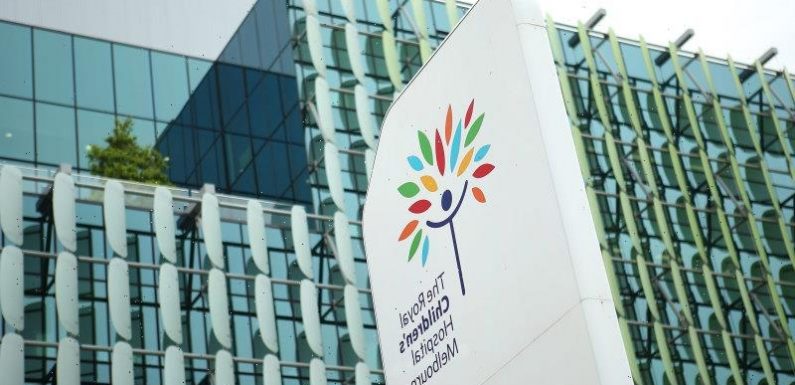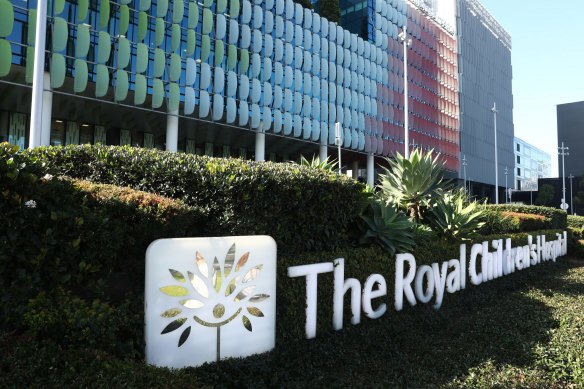
The Royal Children’s Hospital says staff being off sick with COVID-19 and more “extremely unwell” children than usual needing long stays contributed to “unprecedented” waiting times on Monday.
The emergency department in Parkville had 335 presentations on Monday, one of the biggest days on record for the hospital, leading to waits of up to 12 hours for those with less serious conditions.
The Royal Children’s Hospital says the latest rise in coronavirus cases is worsening major staff shortages.Credit:Getty Images
Doctors were called in on their days off to help get through the backlog of emergency patients. The hospital also took the rare step of asking the public to seek alternative care where possible, and seven operations planned for Tuesday were rescheduled.
Children presenting at the hospital on Monday included those with respiratory illnesses, viruses and injuries.
Bernadette McDonald, chief executive of the Royal Children’s Hospital, said COVID-19 was not a major cause of serious illness among children, but the latest rise in coronavirus cases was worsening major staff shortages.
She said the hospital had also come under pressure from a larger than normal number of acutely unwell patients needing long stays.
The hospital, like many across the state, has ongoing staff vacancies, in addition to 120 workers being off with COVID-19 out of 5000 total hospital employees.
“The health system in Victoria and Australia is under pressure. So I can’t see that there are any quick fixes, and the system has to rebuild itself,” McDonald said.
A similar surge event was reported in August during the winter Omicron-variant wave, when the hospital was hit by a “broad spectrum of trauma, mental health, medical illness – the whole spectrum”.
Since then, the Victorian government has joined other states and territories in ending mandatory isolation for people with COVID-19, along with isolation payments for most workers, and state Chief Health Officer Brett Sutton has not appeared at a press conference for more than four months.
Belinda Hibble, Victorian chair of the Australasian College of Emergency Medicine, said there was “absolutely” a link between the pandemic and the pressure on Victorian emergency departments.
“Emergency departments have been under significant strain all year across Victoria, but what we see is this tremendous rise in demand for emergency care that tends to coincide with COVID waves, which we know that we’re experiencing at the moment,” she said.
“Unfortunately, that also coincides with an increase in staff shortages across the system, because people are unwell with COVID or caring for family members that have COVID.
“We have [fewer] available hospital beds because of the rising nursing workforce shortages across the system, which means that patients are stuck for longer in the emergency department and ambulance corridors waiting to access inpatient care.”
The number of Victorians being hospitalised with COVID-19 is on the rise again. As of Tuesday, 720 people in the state were in hospital with the illness, inching closer to the peak of the winter Omicron wave, when about 900 were hospitalised in one day. Twenty people died from the virus in the past 24 hours.
Hibble said there was still a role for public health messaging around COVID-19, such as the importance of vaccination, wearing masks around vulnerable people or considering social distancing “while we still experience the tremendous impact these waves have on our community”.
As the pandemic nears its fourth year, almost every part of Victoria’s health system is battling staff shortages and high demand. There are long waits to see GPs, many specialists are not taking new patients or have excessive waiting lists, and maternity and neonatal wards are struggling to attract a safe number of nurses and midwives.
The Andrews government is offering incentive payments for new nursing, midwifery and general practitioner students, but the infrastructure-heavy focus of the state election campaign disappointed many public health experts, who said it was a lost opportunity for much-needed reform.
Hibble said she was hopeful the latest news of a hospital facing extreme pressure would prompt “some really brave discussions about how we can transform our healthcare system”.
Prime Minister Anthony Albanese, who this week tested positive for COVID-19 for the second time, acknowledged that problems accessing GPs were leading to increased demand on emergency departments.
“The fact is that too many people are turning to various emergency departments, not due to any fault of their own, but because there are no alternatives,” he told Virginia Trioli on ABC radio on Tuesday morning.
“That’s why we, during the election campaign, committed to urgent care clinics that would provide bulk billing services for urgent care, things like a kid with a broken arm, or a child who needs assistance and doesn’t really need to be in an emergency department of the local hospital.”
The Morning Edition newsletter is our guide to the day’s most important and interesting stories, analysis and insights. Sign up here.
Most Viewed in National
From our partners
Source: Read Full Article
